|
|
|
Sort Order |
|
|
|
Items / Page
|
|
|
|
|
|
|
| Srl | Item |
| 1 |
ID:
160478
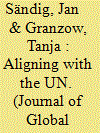

|
|
|
|
|
| Summary/Abstract |
Self-determination campaigns in the Global South have often been pursued through warfare. Since the 1990s, however, an increasing number of such movements have endorsed legalistic mechanisms of international law and the UN's core principle of nonviolence. We introduce the concept of UN-aligned self-determination movements for them. As a starting point to explain their occurrence, we examine two major cases: The Peaceful Southern Movement (Hirak) in Yemen and the Movement for the Actualization of the Sovereign State of Biafra (MASSOB) in contemporary Nigeria. Our analysis combines theories on political opportunities, diffusion, and framing from social movement, civil resistance, and armed rebellion research. We observe that since the end of the Cold War the rule of law, role of the UN, and norms of nonviolent conflict resolution have been strengthened in the international system. We argue that this has given self-determination movements in the Global South new opportunities for claims-making: Facing repressive governments, the leaders of Hirak and MASSOB have successfully aligned their movements with the UN by diffusing its core principles to the local struggle through resonant collective action frames. Thereby, our study contributes to understanding the diffusion of nonviolence in the international system, in particular in self-determination campaigns, and directs attention to the rise of UN-aligned self-determination movements.
|
|
|
|
|
|
|
|
|
|
|
|
|
|
|
|
| 2 |
ID:
196005


|
|
|
|
|
| Summary/Abstract |
Understanding the diffusion of military capabilities is a central issue in international relations. Despite this, only a few works attempt to explain this phenomenon, focusing on threats. This article explains why threats alone cannot account for cybercapacity-development diffusion and introduces a more consistent explanation: the role of alliances. Allies with cybercapacity help partner-countries without cybercapacity start developing their own capacity to increase the alliance’s overall security by reducing mutual vulnerabilities in cyberspace. Partner-countries that lack cybercapacity are eager to accept this option because it is more favorable than developing cybercapacity on their own. Partner-countries may also start investing in cybersecurity to reduce the likelihood of being abandoned in other, conventional, domains. My new cross-sectional time-series dataset on indicators of a state’s cybercapacity-development initiation for 2000–18 provides robust empirical support for this argument and offers important implications for scholarship on arms, allies, and diffusion.
|
|
|
|
|
|
|
|
|
|
|
|
|
|
|
|
| 3 |
ID:
157903


|
|
|
|
|
| Summary/Abstract |
Protests and democratic transitions tend to spread cross-nationally. Is this true of all political events? We argue that the mechanisms underlying the diffusion of mass-participation events are unlikely to support the spread of elite-led violence, particularly coups. Further, past findings of coup contagion employed empirical techniques unable to distinguish clustering, common shocks, and actual diffusion. To investigate which events diffuse and where, we combine modern spatial dependence models with extreme bounds analysis (EBA). EBA allows for numerous modeling alternatives, including diffusion timing and the controls, and calculates the distribution of estimates across all combinations of these choices. We also examine various diffusion pathways, such as contagion among trade partners. Results from nearly 1.2 million models clearly undercut coup contagion. In comparison, we confirm that more mass-driven political events robustly spread cross-nationally. Our findings contribute to studies of political conflict and contagion, while introducing EBA as an effective tool for diffusion scholars.
|
|
|
|
|
|
|
|
|
|
|
|
|
|
|
|
| 4 |
ID:
168307
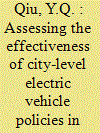

|
|
|
|
|
| Summary/Abstract |
Diffusion of electric vehicles (EVs) is regarded as an important strategy for promoting renewable energy development and controlling CO2 emissions in China. Thus, several incentive measures and policies have been released by the pilot cities in China. The question arises as to whether these policies are effective in promoting the EV deployment. This paper assesses the effectiveness of various EV incentive policies at city level by using the data from 88 Chinese pilot cities. Our regression results show a positive relationship between EV sales volume and two demand-side policies: charging discount and infrastructure construction subsidy. However, purchase subsidy policy is found to have no significant effect. Parking benefits policy shows no effect on promoting EV sales. On the other hand, two supply side policies — model development award and manufacturing award — are not effective. We suggest that local governments may keep those two effective policies, phase out the purchase subsidy policy, terminate the parking benefits policy and suspend the model development award policy. The manufacturing award policy can either be paused or be bundled with other regulations or policies that make specific requirements for EV quality.
|
|
|
|
|
|
|
|
|
|
|
|
|
|
|
|
| 5 |
ID:
133932
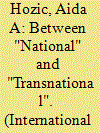

|
|
|
|
|
| Publication |
2014.
|
| Summary/Abstract |
This article explores three modes of film diffusion (markets, festivals, and "alter-routes" facilitated by new technologies) and argues that despite significant lowering of barriers to cultural trade, films are often subject to structural and ideational firewalls linked to the state. Thus, political effects of cultural flows-and of the imaginaries they foster-remain highly contested and fundamentally uncertain.
|
|
|
|
|
|
|
|
|
|
|
|
|
|
|
|
| 6 |
ID:
130994
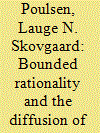

|
|
|
|
|
| Publication |
2014.
|
| Summary/Abstract |
Given the considerable sovereignty costs involved, the adoption of modern investment treaties by practically all developing countries presents somewhat of a puzzle. Based on a review of leading explanations of investment treaty diffusion, the article advances a new theory using behavioral economics insights on cognitive heuristics. In line with recent work on policy diffusion, it suggests that a bounded rationality framework has considerable potential to explain why, and how, developing countries have adopted modern investment treaties. To illustrate the potential of this approach, the case of South Africa is studied in depth.
|
|
|
|
|
|
|
|
|
|
|
|
|
|
|
|
| 7 |
ID:
171138


|
|
|
|
|
| Summary/Abstract |
The emergence of Lethal Autonomous Weapon Systems (LAWS) offers a comparatively low adoption-cost strategy to emerging great powers that would allow them to offset the conventional military advantage enjoyed by their rivals, which threatens the established global balance of power. This article critically analyses the role of China and the United States in the development of the “hardware” and “software” components of LAWS, concluding that, while the demonstration point has not yet been reached, the incubation of this emerging revolution in military affairs has already begun to have a geopolitical impact.
|
|
|
|
|
|
|
|
|
|
|
|
|
|
|
|
| 8 |
ID:
161594
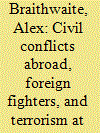

|
|
|
|
|
| Summary/Abstract |
Terrorist attacks in Brussels (May 2014) and Paris (January and November 2015) highlight the threat related to the arrival of foreign fighters (FFs) from civil wars elsewhere. We develop an argument suggesting that terrorism at home is systematically affected by the exit of the so-called FFs out of civil wars abroad. We contend that foreign civil conflicts ending in success for rebel groups can result in a surplus of well-trained FFs, increasing the risk of terrorism at home. By contrast, when rebel groups are defeated in foreign civil conflicts, we anticipate a restriction in the flow of FFs, which reduces the likelihood of terrorism at home. Empirical analyses on most countries for the years 1970 to 2006 support these hypotheses. Our tests also demonstrate that the flow of FFs is associated with the creation of new terrorism campaigns rather than the exacerbation of existing operations.
|
|
|
|
|
|
|
|
|
|
|
|
|
|
|
|
| 9 |
ID:
124674
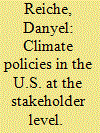

|
|
|
|
|
| Publication |
2013.
|
| Summary/Abstract |
This article analyzes how stakeholders are able to influence climate policy-making in the U.S.; emphasis is placed upon the most popular sports league in the United States, the National Football League (NFL). An empirical analysis of the 32 NFL franchises identifies pioneering clubs that have introduced ambitious green programs that include the utilization of renewable energies, the adoption of energy efficiency measures and carbon offsetting policies, as well as the facilitation of public transport and electric cars. Apart from environmental concerns, this paper identifies several drivers for pioneering actions: economic motives, pressure exerted by the local environment, public relations, and political incentives such as the promotion from the federal government's stimulus package. Finally, this article investigates the role that state actors, such as the Environmental Protection Agency, and non-state actors, such as the Natural Resources Defense Council, play in the innovation and diffusion processes of environmental programs in the NFL.
|
|
|
|
|
|
|
|
|
|
|
|
|
|
|
|
| 10 |
ID:
105163
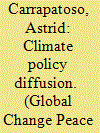

|
|
|
|
|
| Publication |
2011.
|
| Summary/Abstract |
National climate change policies are becoming similar, which can be interpreted as being a result of policy diffusion processes. Many of those policies are inspired by EU climate strategies. The EU actively promotes these policies in its external relations, such as in its partnership on climate change with China. This leads us to three sets of questions. Does the EU act as a transformative power in interregional cooperation on climate change? Can we identify a climate change policy diffusion process in EU-Chinese relations, and, if so, which communication channels as well as diffusion mechanisms can be identified? And, finally, is interregional cooperation on climate change a building block or a stumbling block in the global climate change regime? This article argues that the policy diffusion process depends on the scope of the interregional communication process between the EU and China, and the willingness and national responsiveness of China to adopt policy innovations.
|
|
|
|
|
|
|
|
|
|
|
|
|
|
|
|
| 11 |
ID:
142490
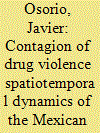

|
|
|
|
|
| Summary/Abstract |
Why are some territories ravaged by intense levels of criminal violence while others are relatively peaceful? This research contributes to an understanding of the escalation and diffusion of drug violence in Mexico from 2000 to 2010 by formalizing the interactions between the state and organized criminals and by relying on a large database of event data containing more than 1.6 million observations. Results based on spatial econometrics provide evidence of the spatial diffusion of violence. In congruence with the theoretical expectations, the results show that the disruptive effect of law enforcement is an important catalyst for the intensification of violence between criminal organizations, especially when deployed in areas hosting a high concentration of criminal groups. This relationship holds for a broad menu of violent and nonviolent law enforcement tactics. The analysis also reveals that other broadly held factors (international, geographic, and socioeconomic characteristics) have a modest effect on the dynamics of drug-related violence.
|
|
|
|
|
|
|
|
|
|
|
|
|
|
|
|
| 12 |
ID:
128979


|
|
|
|
|
| Publication |
2014.
|
| Summary/Abstract |
Civil conflict appears to be contagious-scholars have shown that civil wars in a state's neighborhood make citizens more likely to rebel at home. However, war occurs when both rebels and the state engage in conflict. How do state authorities respond to the potential for civil conflict to spread? We argue that elites will anticipate the incentive-altering effects of civil wars abroad and increase repression at home to preempt potential rebellion. Using a Bayesian hierarchical model and spatially weighted conflict measures, we find robust evidence that a state will engage in higher levels of human rights violations as civil war becomes more prevalent in its geographic proximity. We thus find evidence that states violate rights as a function of the internal politics of other states. Further, we argue authorities will act not to mimic their neighbors but rather to avoid their fate.
|
|
|
|
|
|
|
|
|
|
|
|
|
|
|
|
| 13 |
ID:
069800
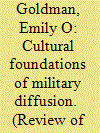

|
|
|
| 14 |
ID:
147833
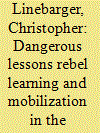

|
|
|
|
|
| Summary/Abstract |
Contemporary research on the international diffusion of civil conflict privileges physical, proximity-based variables like conflict spillover and refugee flows. I argue that the international diffusion of civil strife can occur through a learning mechanism, and that this phenomenon may occur on a worldwide basis. Individuals most likely to rebel, or proto-rebels, may learn about the utility of rebellion before mobilizing and violently challenging the state. Such international learning therefore occurs during the pre-conflict process. International sources by which proto-rebels learn include active, ongoing civil wars, as well as revolutionary governments that have been founded by rebels victorious in past wars. Revolutionary governments radically shock the international system, teaching proto-rebels about the possible benefits to be gained from violently challenging the state. In order to test these assertions, I undertake empirical analyses using militant organization data that capture the year in which rebel movements first emerge, during the period 1968–2001. I then explore the spatial and temporal relationships between rebel movement emergence, civil conflict, and revolutionary regimes, using the country-year as my unit of analysis. I further examine how these relationships are attenuated by cultural and regime-type similarity. I find, in line with the literature, that active civil conflicts generally inspire rebel mobilization only in directly neighboring states, while revolutionary regimes established after rebel victories are associated with mobilization on a global basis. I conclude that proto-rebels learn and take inspiration from some global sources of information, and that significant analytical utility is to be gained by focusing on revolutionary regimes established as a result of rebel victories, as well as mobilization in the pre-conflict process.
|
|
|
|
|
|
|
|
|
|
|
|
|
|
|
|
| 15 |
ID:
107444
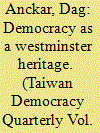

|
|
|
|
|
| Publication |
2011.
|
| Summary/Abstract |
Conventional wisdom from colonial history research has it that the states which
the British left behind them were better equipped for democratic government
than the states that had belonged to other colonial powers. Investigating the
democracy fortunes of all fifty-four territories that were freed following World
War II from British control, and applying Freedom House ratings to determine
democracy status, this study examines the belief that democratic government
has become a characteristic feature of former British possessions. Findings are
that the former colonies may be ordered roughly into three groups. Whereas
seventeen countries since 1972 have always, or almost always, been classified as
democracies, a larger portion, consisting of twenty-three countries, has always,
or almost always, been ranked as non-democracies. The remaining fourteen
countries represent an in-between category. On the whole, therefore, the idea
that democracy is a central part of the Westminster heritage overall cannot
be supported. Explanations for the division of the former colonies into three
groups have been researched in different directions, and the efforts substantiate
earlier observations in the literature on the relevance to democratization of
factors that relate to state size, modernization, and geography. Concerning the
impact of the length of colonial rule, the findings confirm an earlier suggestion
by Samuel Huntington that colonies which had a long British presence have
been particularly well equipped to develop into stable democracies.
|
|
|
|
|
|
|
|
|
|
|
|
|
|
|
|
| 16 |
ID:
117630
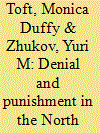

|
|
|
|
|
| Publication |
2012.
|
| Summary/Abstract |
A growing literature on the subnational diffusion of armed conflict rests on the proposition that political violence triggers more violence, in the same locality and elsewhere. Yet state efforts to contain such uprisings remain largely unexplored, theoretically and empirically. Drawing on a mathematical model of epidemics, we formalize the logic of conflict diffusion and derive conditions under which state coercion might limit the spread of insurgent violence. Using a new dataset of insurgent and government violence in Russia's North Caucasus from 2000 to 2008, we evaluate the relative effectiveness of four coercive strategies: (1) denial, which manipulates the costs of expanding insurgent activity to new locations, (2) punishment, which manipulates the costs of sustained fighting in contested areas, (3) denial and punishment, which does both, and (4) no action, which does neither. We find denial to be most effective at containing insurgent violence. Punishment is least effective, and even counterproductive. Not only does such a strategy fail to prevent the spillover of violence to new locations, but it may amplify the risk of continued fighting in contested areas. In the Caucasus, denial is found to be the least inflammatory counter-insurgency option for Russia. For it to succeed, Russia should physically isolate centers of insurgent activity from regions of nonviolence and avoid the temptation of punitive reprisals.
|
|
|
|
|
|
|
|
|
|
|
|
|
|
|
|
| 17 |
ID:
186406
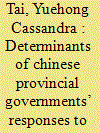

|
|
|
|
|
| Summary/Abstract |
Scholars who study governance in authoritarian countries have long highlighted the importance of fiscal capacity and pressure from the central government in determining the responsiveness and policy changes of subnational governments. However, policy orientation is also important in shaping how subnational governments react to a crisis. Using provincial governments’ responses during the 2018 Chinese vaccine scandal, I find strong evidence that an emphasis on public health, as well as early responses by neighboring provinces, increased the likelihood of a quick response. Moreover, issue salience minimized the direct effect of pressure from the national government. An additional paired case study of the provinces of Hubei and Hunan shows that the importance accorded by the provincial government to public health policy was implemented at the sub-provincial level through China’s one-level-down cadre management system; it also may explain Hubei’s delay in responding to COVID-19 at an early stage.
|
|
|
|
|
|
|
|
|
|
|
|
|
|
|
|
| 18 |
ID:
148311
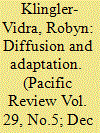

|
|
|
|
|
| Summary/Abstract |
Diffusion scholarship expects little adaptation of core elements of policy models. However, the empirical reality is different; diffusion of even highly regarded models, such as the Silicon Valley venture capital (VC) policy model, results in marked adaptation. This article demonstrates why the Silicon Valley VC model is necessarily adapted differently by policy-makers in the geographically, ethnically and economically proximate states of Hong Kong, Taiwan and Singapore. More specifically, these policy-makers' interventionist orientations, private sector financing preferences and international versus domestic firm promotion biases drive contextually rational – and unique – adaptations of the Silicon Valley VC policy model.
|
|
|
|
|
|
|
|
|
|
|
|
|
|
|
|
| 19 |
ID:
133753
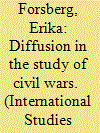

|
|
|
|
|
| Publication |
2014.
|
| Summary/Abstract |
This essay reviews diffusion as studied in large-N civil war research. In doing so, a number of pitfalls and lacunae are identified. First, the definition of diffusion as a process-whereby internal conflict in one location alters the probability of internal conflict erupting in another location at a later point in time-entails a number of difficulties for empirical modeling. Researching such a process involves an attempt to study a phenomenon that, in essence, is unobservable. It also creates difficulties in identifying relevant units of analysis, because the process involves at least two units. Second, diffusion is customarily identified based on correlations within a spatial and temporal proximity. Classifying it in this way risks simultaneously over- and underestimating cases of diffusion, which in turn generates uncertainty regarding the main determinants of diffusion. With these observations in mind, this essay ends with a word of caution for policymakers, with relevance extending beyond diffusion of civil war.
|
|
|
|
|
|
|
|
|
|
|
|
|
|
|
|
| 20 |
ID:
147903


|
|
|
|
|
| Summary/Abstract |
Many scholars and policymakers are concerned that the emergence of drone warfare—a first step toward the robotics age—will promote instability and conflict at the international level. This view depends on the widely shared assumption among International Relations scholars that military hardware spreads easily, especially in the age of globalization and real-time communications. In this article, we question this consensus. Drawing from the literature in management, we advance a new theory of diffusion of military innovations and test its two underlying causal mechanisms. First, we argue that designing, developing, and manufacturing advanced weapon systems require laboratories, and testing and production facilities, as well as know-how and experience that cannot be easily borrowed from other fields. Second, we argue that the adoption of military innovations requires both organizational and infrastructural support. We test our two claims on three types of combat-effective drones: loitering attack munitions (LAMs), intelligence surveillance and reconnaissance drones (ISR), and unmanned combat autonomous vehicles (UCAVs). We find that even wealthy, advanced, and militarily capable countries such as the United States, the United Kingdom, Germany, and France have struggled to produce or adopt such platforms. We conclude that concerns about the diffusion of drone warfare appear significantly exaggerated, as do claims that globalization redistributes military power at the global level. More generally, our analysis sheds light on how the interaction between platform and adoption challenges affects the rate and speed of diffusion of different military innovations.
|
|
|
|
|
|
|
|
|
|
|
|
|
|
|
|
|
|
|
|
|